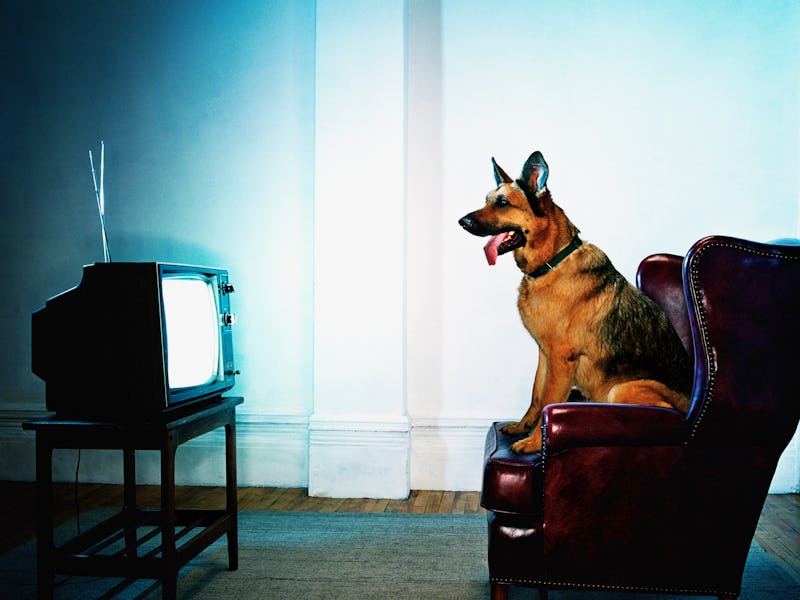Your dog’s TV habits could help scientists unlock new insight into aging
Scientists are hoping to one day develop a vision test for dogs.

How can we test a dog’s aging eyes? Give them an eye chart and ask if the little E is blurry? That probably won’t work. So now they are asking dog owners around the world for their help.
It’s a seemingly simple question, but with no easy answer in sight. When humans go to the ophthalmologist, we sit down and look at an eye chart. Our ability — or lack thereof — to read ever-smaller letters can indicate age-related vision losses.
“There's no way that we could test that method in a dog,” Freya Mowat, assistant professor of ophthalmology at the University of Wisconsin-Madison’s Department of Surgical Sciences, tells Inverse.
So Mowat thought of something else: By figuring out what content dogs find most visually engaging, like the kind of TV they watch while curled up on the couch with their owners, she could develop a visual test that dogs might actually have the attention span for. And now they are asking dog owners around the world for their help in determining what TV canines actually like.
Researchers explain how your dog’s TV viewing habits could help develop a vision test for canines.
How do TV habits help unpack vision in dogs?
As a veterinary ophthalmologist, Mowat has been hard at work trying to develop a vision test for dogs that would be equivalent to the eye chart humans use.
Since dogs and small children are somewhat similar in terms of their development, Mowat first tried to apply the vision test for children to canines. Instead of using the vision test for adults, instead, ophthalmologists hold up cards with strips whose thickness varies, similar to the different-sized letters on adult charts.
Unfortunately, the test couldn’t hold the dogs’ attention long enough for veterinarians to check their vision. Part of the problem is that “dogs just get bored really fast,” Mowat says.
After that experience, Mowat realized “we have to really start thinking outside the box beyond what's already done in any type of person.”
Her research team realized that video content — like the shows on your TV — might be engaging enough to hold a dog’s attention because it taps into a dog’s natural instincts as a predator.
“Something moving is probably more likely to get their attention and maintain it,” Mowat explains.
But before Mowat could start bringing dogs into a laboratory to view video content and ultimately develop a vision test, she’d need to first understand the type of content that best engages numerous dogs across different breeds.
Creating an equivalent dog vision test to the human vision test could help researchers draw parallels between canine and human health.
How to participate in the dog study
Mowat developed an online survey that any dog owner around the world can participate in. The questionnaire takes about 15 minutes, and she assures privacy is maintained.
Ultimately, Mowat is hoping to get thousands of responses over the next few months to inform her future research. The link to the questionnaire is available here.
“What we want to do with this survey is establish meaningful content for us to do laboratory studies with pet dogs,” Mowat explains.
But if you want to learn a little more about how Mowat got here — and how your canine’s TV habits could eventually help researchers develop a vision test for dogs — then read on.
“This is the first step in a long road,” Mowat says.
After researchers figure out the most engaging visual content based on the questionnaire responses, they could use that content to develop a vision test in the future. It’s unclear what that would look like, but it might involve fading the content or making it smaller to test the pups’ eyesight. But first, they need to hook the dogs with exciting content that will grab their attention.
“If we don't get the content right, then the test is useless,” Mowat says.
How this dog research could help humans
After Mowat finished her clinical residency in ophthalmology, she says she came out “with this sort of deep understanding of dog vision.”
She has a specific reason for wanting to study vision: It is a clear measure of aging. Certain markers of vision decline as we age.
“You see the implications of vision loss in people as causing and contributing to things like social isolation, depression, anxiety, dependence on others,” Mowat says.
Since humans spend much of their time in close proximity to their canine companions, it’s possible environmental or other factors contributing to age-related vision loss in dogs would also be present in their human owners.
“They snuggle with them at night, they share their dinners with them, they go running with them in the park,” Mowat says, adding: “The environment and our lifestyle are sort of connected between the dog and the human.”
By studying aging in dogs, you can potentially better understand how humans age too — and on a much shorter timescale, since dogs’ lifetimes are a fraction of the average human lifespan. If there are environmental issues impacting age-related vision issues in dogs, researchers may be able to determine whether similar issues persist in humans living in the same household. That’s why it’s so crucial to develop an equivalent eye test for dogs just as exists for humans.
“Even if the tests aren't identical, they're testing the same component of our health,” Mowat says.
This article was originally published on